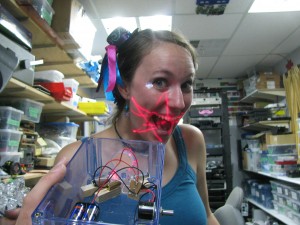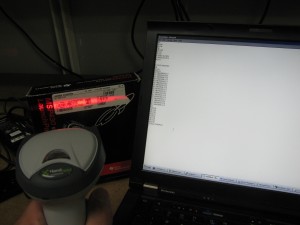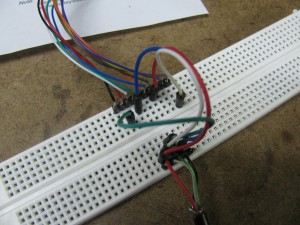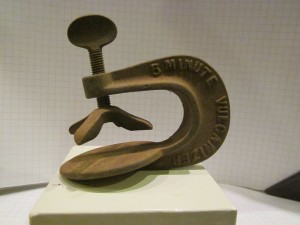Dewar + Paint + Vinyl = N2D2
What’s better than a liquid nitrogen dewar? A liquid nitrogen droid.
Sincerely hoping there’s no regulation against painting these things…

When Karen (yes, that Karen) decided to host a DIY birthday party, and said that she wanted people to make flowers, my mind went blank. Mario brought casting resin to make plastic flowers, Roger brought color-changing LEDs that got used in a bunch of things. I saw flowers made of yarn, flowers made of vinyl, flowers made of piano keys, flowers made of filter media, flowers made of sheetmetal, flowers made of mylar, and of course, flowers made of Red Bull cans. Still having no ideas, I decided to ignore the party for a bit, and started salvaging some motors from a soon-to-be-recycled CDROM drive.
Then something clicked: At Tuesday’s electronics meetup, we used signal generators and oscilloscopes to display Lissajous curves. With a laser and some mirrors and some motors, I could make Rose curves! Those are flowers, right? Flowers made of light!
The only small mirror available was still much too large, so it got cracked into a bunch of sharp but useful little pieces. With some hot glue, some solder, and a quick trip to the bin of lasers, I had a rudimentary optical path. Joe helped set up a quick-and-dirty pot-and-FET motor speed control (inspired by reading an article about PC PSU testing a few days ago), and with a few more minutes’ work, the whole thing was stuffed into a project box and shooting flowers onto everything within reach, including Karen. Happy Birthday!
-Nathaniel-
(Caution: Laser light emitted from this aperture. Warning: Whirling bits of broken glass within this aperture. Danger: Flowerguns are addictive.)
What do you get when you mix an old 10/100 NIC, a handful of components, and a home server that goes off into the weeds once in a while? A network-connected reset button, and the ability to recover from the majority of mishaps! The concept is simple: Use a standalone NIC’s Wake-on-LAN capability to poke a different signal, specifically, the PC’s reset line. Best yet, the whole thing costs less than $3, and goes together in under an hour. Not too shabby, when you consider that comparable network-aware remote-reboot devices go for about $200!
The important realization behind the project is that a WoL-capable NIC can run standalone, given nothing but power. It seems so obvious in retrospect! This same concept could be easily used to drive an SSR for true cold-boot capability, interface with a UPS for output-disable, or other functions.
(UPDATE: There’s prior art! Their version is called “whack-on-lan” and uses a NIC without the retriggering problem, so their circuit is much simpler.)
Lots and lots of detail after the break…
 At the Hamvention fleamarket, Dustin got an amazing price on a Handheld Products 3800r barcode scanner, probably because the cable wasn’t included. The connector on the bottom of the scanner is a nonstandard 10p10c (aka RJ50), so most folks wouldn’t just be able to make one, but buying a $57 cable for a $1 scanner seemed silly. Further frustrating the situation is that Handheld (acquired by Honeywell) is pretty tight-lipped about certain info. The pinout for the RS232 cable (p/n 42206300) was easy enough to find, but the innards of the USB cable (p/n 42206161 or 42206203) proved elusive.
At the Hamvention fleamarket, Dustin got an amazing price on a Handheld Products 3800r barcode scanner, probably because the cable wasn’t included. The connector on the bottom of the scanner is a nonstandard 10p10c (aka RJ50), so most folks wouldn’t just be able to make one, but buying a $57 cable for a $1 scanner seemed silly. Further frustrating the situation is that Handheld (acquired by Honeywell) is pretty tight-lipped about certain info. The pinout for the RS232 cable (p/n 42206300) was easy enough to find, but the innards of the USB cable (p/n 42206161 or 42206203) proved elusive.

Luckily for Dustin’s iTrackMine habit, i3’s electronics lab had a set of 10p10c crimpers and a box of connectors (and a resourceful mentor geek), waiting to solve just such a problem. After building a little 10p10c breakout cable and a USB breakout cable, some breadboard jumper wires made it relatively straightforward to investigate every permutation until the device enumerated. (Note that ‘straightforward’ does not equate to ‘quick’.)
For the purpose of saving some hapless future scanner technician some time, the pinout is as follows:
| USB pin number | function | color | 10p10c pin number |
| 1 | +5 (Vcc) | Red | 7 |
| 2 | D- | White | 10 |
| 3 | D+ | Green | 2 |
| 4 | Gnd | Black | 4 |
First, it’s difficult to position the wires in a modular connector if you’re not using every position. Stuffing the unused ones with little stubs of wire made it easy to guide the relevant wires into position.
Second, modular connectors can be reinforced by flooding the back with hot-melt glue. (This works very well on cat-5 patch cords.) Since this build used a flexible, thin USB cable in a giant 10p10c connector, the glue is the only reason it didn’t fall right out.

 After moving back to Michigan nearly eleven years ago, my father-in-law introduced me to the fun of going to auctions. In particular, we like to go to auctions that have lots of tools and machinery, which, in Southeast Michigan, are plentiful. As a result, we’ve bought our share of what are known as box lots, which are literally boxes full of things that really aren’t worth trying to sell individually–miscellaneous fasteners, hand tools, fishing reel parts, lead weights, and left-threaded bipolar frobulators. My father-in-law is so devoted to auctions, he’ll sometimes bid on these things just to keep the sale moving. Most of the time, the items are fairly mundane, but occasionally we get something that is either beautiful, mysterious, or sometimes both! Rather than keep them secreted away until someone buys them at my estate auction, I’m going to share them (virtually) here in what I hope will be an irregular series. In each installment, I (or others–guest tools are welcome!) will share a couple of tools that are either aesthetically pleasing examples of bygone industrial design or non-obvious in their purpose and/or use. The goals are to share the beauty of these tools, have some fun, and maybe learn something too.
After moving back to Michigan nearly eleven years ago, my father-in-law introduced me to the fun of going to auctions. In particular, we like to go to auctions that have lots of tools and machinery, which, in Southeast Michigan, are plentiful. As a result, we’ve bought our share of what are known as box lots, which are literally boxes full of things that really aren’t worth trying to sell individually–miscellaneous fasteners, hand tools, fishing reel parts, lead weights, and left-threaded bipolar frobulators. My father-in-law is so devoted to auctions, he’ll sometimes bid on these things just to keep the sale moving. Most of the time, the items are fairly mundane, but occasionally we get something that is either beautiful, mysterious, or sometimes both! Rather than keep them secreted away until someone buys them at my estate auction, I’m going to share them (virtually) here in what I hope will be an irregular series. In each installment, I (or others–guest tools are welcome!) will share a couple of tools that are either aesthetically pleasing examples of bygone industrial design or non-obvious in their purpose and/or use. The goals are to share the beauty of these tools, have some fun, and maybe learn something too.
To kick it off, I’m sharing a couple of recent finds. First off: goggles. The goggles shown here are fairly uncomfortable (and they could use a good cleaning), but I love them because they’re just so wonderfully archaic! The aluminum frames and glass lenses suggest a manufacture date in the 1940’s, but that’s just a guess. The levers on the sides appear to allow the lenses to be removed for replacement (or cleaning), though I haven’t been able to get them to move; there is a bit of corrosion on them and I’m afraid I’ll break them if I push them too hard. The leather strap on the bridge allows for a bit of adjustment; the buckle is thoughtfully placed so that it is facing outward, rather than pressing against the bridge of the nose. The padding around the eyes is some kind of plastic or rubber which may have been pliable at some point but is now rather brittle. The cheap staples that hold the pads on is a little incongruous with the overall quality of the goggles, making me wonder if perhaps they’re an after-market mod. Given that the lenses are glass (and seemingly not impact-resistant), I’m guessing that these were probably meant to be used for welding. What do you think?
 My other recent find is less showy, but it makes up for it with a bit of mystery. The “5 Minute Vulcanizer” clearly has something to do with rubber, but I don’t know how it might have been used. Perhaps it was used for patching the sidewalls of tires that appeared on cars like the Model T? Or, perhaps its rustiness is fooling me into thinking it’s older than it really is. Please register your educated opinions, observations and wild guesses in the comments! And, if you want a larger picture, click on either photo to see it in its full 4000 x 3000 resolution.
My other recent find is less showy, but it makes up for it with a bit of mystery. The “5 Minute Vulcanizer” clearly has something to do with rubber, but I don’t know how it might have been used. Perhaps it was used for patching the sidewalls of tires that appeared on cars like the Model T? Or, perhaps its rustiness is fooling me into thinking it’s older than it really is. Please register your educated opinions, observations and wild guesses in the comments! And, if you want a larger picture, click on either photo to see it in its full 4000 x 3000 resolution.
Until next time….
